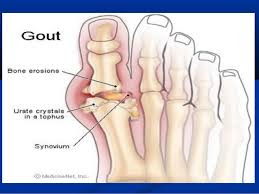Gout has many well-known symptoms, including extreme pain, swollen joints, warmth, and redness. While all cases of gout are the result of uric acid crystal build-up, it can present in unexpected or unusual ways.
Flu-like Symptoms. The inflammation experienced during gout flare-ups can become severe enough to cause flu-like symptoms, including high fever, muscle aches, and fatigue.
Kidney Stones. Gout can cause uric acid crystals to build-up in the kidneys, leading to kidney stones. Between 10% and 25% of gout sufferers develop kidney stones, and may experience them with or without more commonly recognized symptoms, like joint inflammation. Kidney stones can be excruciatingly painful and can lead to kidney damage or kidney failure if left untreated.
Sacroiliac joint pain. Gout is commonly associated with the big toe joint (metatarsophalangeal joint), but only about half of cases occur there. The remaining cases affect other areas, such as knees, fingertips, and—less often—sacroiliac joints, which are located on either side of the pelvis between the sacrum and the ilium. Gout in a sacroiliac joint can cause low back pain or hip pain.
Wrist Pain. People who experience gout-related wrist pain typically have polyarticular gout, meaning their gout affects more than one joint. Gout pain appearing only in the wrist is rare but possible. When a person has gout in a joint that is not known for its susceptibility to gout, such as the wrist or ankle, an accurate gout diagnosis can be elusive. If the joint is swollen, the physician may aspirate it with a needle and send the joint fluid to a lab for diagnostic analysis.
Gout symptoms typically have rapid onset and resolve within days or weeks. If left untreated, however, it can become chronic and cause lasting damage. Sufferers should seek treatment for gout during an episode to prevent future attacks.
References
Harvard Medical School, “Gout: Joint pain and more,” Harvard Medical School Family Health Guide http://www.health.harvard.edu
National Kidney Foundation, “Gout and Hyperuricemia,” National Kidney Foundation http://www.kidney.org
NHS Choices, “Gout – Complications,” NHS http://www.nhs.uk/Conditions/Gout/
Riddell CM, Elliott M, Cairns, AP, “An Unusual ‘Gouty’ Case of Back Pain and Fever,” J Rheumatol October 2008 35(10):2076-2077
Mantle B, Gross P, Lopez-Ben R, Alarcón GS, “Hip pain as the presenting manifestation of acute gouty sacroiliitis.” J Clin Rheumatol. 2001 Apr;7(2):112-4. PubMed PMID: 17039107
Konatalapalli RM, Demarco PJ, Jelinek JS, Murphey M, Gibson M, Jennings B, Weinstein A., “Gout in the axial skeleton,” J Rheumatol. 2009 Mar;36(3):609-13. doi: 10.3899/jrheum.080374. Epub 2009 Feb 4. PubMed PMID: 19208604
Jacobs CL, Stern PJ, “An unusual case of gout in the wrist: the importance of monitoring medication dosage and interaction. A case report,” Chiropr Osteopat. 2007; 15: 16. PMCID: PMC2174925

Comments
Post a Comment